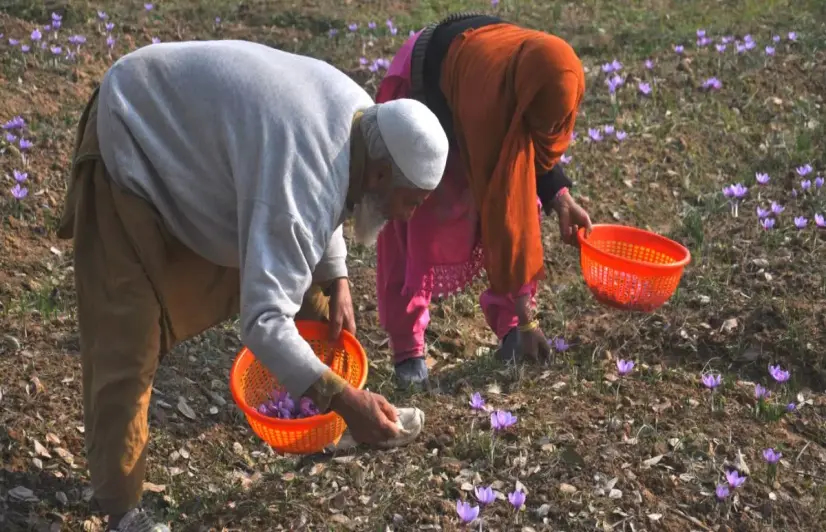Kashmir’s saffron farmers ditch ‘red gold’ for apples, almonds

Kashmir’s saffron farmers ditch ‘red gold’ for apples, almonds
Dwindling yield due to climatic change, damage of irrigation facilities by the 2014 flood have forced saffron farmers to look for other options.
Srinagar: Launched with much hype in 2010-11, the Rs 400-crore
National Saffron Mission (NSM) has turned out to be a damp squib in Jammu and
Kashmir after a decade. There has been a decrease of around 60 per cent in both the
yield and area under cultivation of saffron. Considered the best in the world for
its flavour, colour and aroma, Kashmiri saffron had earned a sobriquet of ‘red gold.
In Kashmir,
saffron is cultivated mainly in three districts — Pulwama, Budgam and Srinagar.
Of these, the Pampore region of Pulwama district in south Kashmir has earned the
title of “Kashmir’s saffron bowl” for growing the highest quantity and best
quality saffron. The soil quality in this area is highly suitable for its
cultivation.
According
to official data, the area under saffron cultivation in Pampore has declined from
5,707 hectares in 1996 to 3,500 hectares in 2021. Saffron is also cultivated in
other parts of the district, but the largest proportion of cultivation takes
place in Pampore which has also become a tourist attraction during saffron
flower bloom.
Saffron
flowers are sensitive to the vagaries of weather, and their production depends on weather
conditions and irrigation facilities. The decrease in both production and area
under cultivation has taken place at a time when the government has pumped in
crores of rupees under the NSM.
Chief agriculture
officer of Pulwama, G M Dhobi told 101Reporters
that the NSM had run smoothly till 2014. “But the 2014 floods in Kashmir
damaged the infrastructure that was set up for the irrigation of saffron fields
and other farming activities. The saffron seed carves used for sowing are highly
climate-sensitive. They are damaged by both scanty and heavy rainfall. Hence, it
took us years to recover from the losses caused by the 2014 floods. Seed
availability and seed multiplication were also affected. Now the department is
in the revival mode, and we are expecting better results," he said.
Dhobi said
that the Department of Agriculture had launched a project to set up 111 bore wells
on Pampore’s saffron fields, out of which 74 had been completed. This would boost
saffron cultivation, he said.
The officer
said that cultivation on a one-hectare saffron field could produce a yield of 1
kg of saffron which had a market value of Rs 1.8–2.15 lakh. He said that initially, they were facing the issue of adulteration, but after the Kashmiri saffron got its
Geographical Indication (GI) tag, the practice has been under tight scrutiny.
Dhobi also appealed to the farmers to not switch to horticulture crops such as apples in the region because the land in Pampore was the best suitable for saffron cultivation. “We need to start a massive awareness drive among the saffron growers. The process is on,” he said.
Over the last decade, there has been a decrease of around 60 per cent in both the yield and area under cultivation of saffron in Kashmir (Picture credit - Sameer Showkin Lone)
There had
been more than 20,000 families engaged in saffron farming in Pampore a decade
ago, but of late, the number dwindled to around 16,000, said Abdul Majeed Wani, the president of the Saffron Growers Association. The farmers cite climatic change and poor
irrigation facilities as the major reasons for the decline in saffron
production.
Ghulam
Mohammad, a saffron farmer who switched to apple plantation and cultivation of vegetables
on his 60-cent plot of land in Pampore, said, “Fifteen years ago, we were able
to harvest two to three kilograms of saffron from the plot which later declined
to 900 grams. We then planted other crops such as apples on this land. These will
fetch us more income than cultivating saffron,” he said, adding that many farmers
had also sold their lands following the decline in the yield from saffron
fields.
Bashir
Ahmed, a 55-year-old farmer, said he used to cultivate saffron on his one-acre land.
Each year he used to harvest around two kilograms of saffron worth around Rs
1.8–2 lakh. However, five years ago, switched to cultivating apple and almonds on
the land after the saffron yield started declining.
“I earned Rs 80,000 from the apples I cultivated on 50 cents of land. This year, it went up to Rs 1,30,000. Even though the yield from apple trees is low in the initial years, it keeps increasing each year. Apple trees are giving me better returns than saffron cultivation,” Ahmed said, adding that the decline in saffron yield and the low market rates were what prompted him to look for other options.
Land mafia and illegal excavation
Officials in the Directorate of Agriculture, who wished not to be named, told 101Reporters that illegal soil excavation had become a major threat to saffron farming in Kashmir Valley, especially in Pampore. They blamed the district administration for not taking strict measures to stop the illegal act.
Picture credit - Sameer Showkin Lone
"Even
when any action is taken, the excavation stops for a few days, and then it starts again.
Until the government imposes a strict ban on excavation, the land mafia will
continue to pose a serious threat to the fertile land of the saffron
bowl," said an officer.
They said that the farmers were also to some extent responsible for allowing the soil excavation. "They being the owners the lands, the soil excavation for other purposes such as construction works cannot take place without their consent,” the officer said.
Would you like to Support us
101 Stories Around The Web
Explore All NewsAbout the Reporter
Write For 101Reporters
Would you like to Support us
Follow Us On



